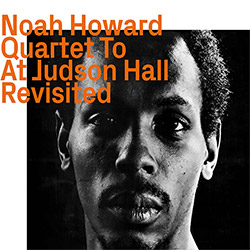
Saxophonist Noah Howard's move from New Orleans to New York City brought him into the circle of early 60's free jazz players including Albert Ayler, joining Sun Ra's Arkestra, and performing at Slug's Saloon; this release reissues two ESP albums, his working band's 1966 Quartet album, and the extended and interestingly orchestrated sextet album, At Judson Hall.
In Stock
Quantity in Basket: None
Log In to use our Wish List
Shipping Weight: 3.00 units
EU & UK Customers:
Discogs.com can handle your VAT payments
So please order through Discogs
Sample The Album:
Noah Howard-alto saxophone
Ric Colbeck-trumpet
Scotty Holt-double bass
Dave Grant-percussion
Dave Burrell-piano
Catherine Norris-cello
Sirone-double bass
Bobby Kapp-percussion
Click an artist name above to see in-stock items for that artist.
UPC: 752156115229
Label: ezz-thetics by Hat Hut Records Ltd
Catalog ID: ezz-thetics 1152
Squidco Product Code: 33213
Format: CD
Condition: New
Released: 2023
Country: Switzerland
Packaging: Cardboard Gatefold
Tracks 1-4 recorded in New York City, in Janurary, 1966.
Tracks 5 and 6 recorded at Judson Hall, in New York City, on October 19th, 1966.
Noah Howard Quartet originally released in 1966 as a vinyl LP on the ESP Disk label with catalog code 1031.
At Judson Hall originally released in 1968 as a vinyl LP on the ESP Disk label with catalog code 1064.
"By 1966, the first wave of free jazz had established the foundation upon which this radically generated music could be understood and personalized, shared as a communal activity and still invested with significant singular characteristics. Ornette Coleman, Cecil Taylor, John Coltrane, Sun Ra, and Albert Ayler represented the "establishment," the stylistically varied and manifestly recognizable voices whose recordings spread the possibilities of sound exploration and distinctive forms of expression around the world. But it frequently requires the direct influence and interaction of a local scene to expand the parameters of creativity, to develop the potency of an individual perspective. Hence these, the debut recordings of Noah Howard.
Howard's musical odyssey began in New Orleans, where he was born in 1941, indoctrinated in the sounds of the Southern church, the blues, and the multifaceted popular styles that energize the Crescent City including r&b and the jazz of Louis Armstrong, Duke Ellington, and Charlie Parker. He started playing saxophone and trumpet, joined the armed forces in 1960, and relocated to the West Coast after two years in the service, where, after hearing John Coltrane on record, he connected with trumpeter Dewey Johnson and saxophonists Byron Allen and Sonny Simmons. His 1965 move to New York brought him into a larger circle of like-minded musicians, initiated by a stint in the Sun Ra Arkestra, and a friendship with Albert Ayler. But equally valuable were the informal sessions centered around the Cooper Square building where critic and poet Amiri Baraka, saxophonists Archie Shepp and Marion Brown lived, as well as Slugs', a club in the East Village.
The quartet recording here, from January 1966, documents Howard's first "working band" and reflects the impetus of the specific time and place, albeit from the reconsidered point-of-view of a second generation of freethinkers. This is not the urgent abandon of the Ayler brothers, nor the anthemic exaltations of post-Ascension Coltrane. Howard's alto saxophone essays a different sense of lyricism, a forward momentum that knits cries and sharp motifs in and out of pitch designations into an extended melodic contour, closer to the after-Parker extensions of Jackie McLean's razor's-edge tonality, still projecting the chordless values of Let Freedom Ring (with upper-register squeals as much a part of r&b - hear Willis Jackson on "Gator Tail" for one example - as Ayleresque), and Marion Brown's soon-to-be-documented (and Southern inspired?) contemplative impressionism - both players to be heard often gigging at Slugs'.
Howard's bandmates were products of the same interactive scene. Although trumpeter Ric Colbeck was a transplanted Brit weaned on trad jazz, he was quickly swept up in the maelstrom of his new surroundings, as he related to Richard Williams in 1970, "After one week in New York your playing changes....We played in a lot of lofts and at Slugs', there was a lot of playing at cats' pads on the Lower East Side, with Trane and Pharoah and Dewey Johnson all rehearsing there. The music isn't deliberately programmatic - it's just the way we play, with that intensity." Howard and Colbeck work well together - alto saxophone and trumpet often exploiting counterpoint as an agenda of motivic investigation, with Scotty Holt's remarkable bass interludes as grounding force and Dave Grant's drums filling the spaces in between. (The community sensibility is further illustrated by McLean's hiring of Holt from '66-68, and Grant's appearance with Marion Brown on pianist Burton Greene's '65 album.)
The musical qualities revealed nine months later in the concert At Judson Hall shows how quickly creative attitudes - specifically Howard's - were expanding. The shift in personnel is an organic one; pianist Burrell, bassist Jones (aka Sirone), and drummer Kapp had been working together for some time, ultimately in preparation to record Burrell's take on Leonard Bernstein's music from West Side Story, and both the pianist and bassist would shortly contribute, together and separately, to several Marion Brown recordings. Howard's conception now places a greater focus on arrangement, with layers of shifting involvement amid fluid instrumentation. Burrell's delayed entry on "This Place Called Earth" comes as a surprise, and his rhapsodic leanings symbolize the musicians' quest. Likewise, the cello and bass introduction to "Homage to Coltrane" sets an uneasy, dramatic tone (with raga undercurrents that continue throughout), allowing Colbeck's controlled trumpet and Howard's anguished alto to gradually build a mood that suggests as much ecstasy as elegy (although Coltrane was not to pass away until 1967).
As compelling as these two albums are, they represent just the beginning of a career of determination and resourcefulness that stretched over five decades, two continents, and dozens of recordings, from roots music to world music, yet never receiving the attention one might expect. This is an opportunity to remedy a portion of that neglect."-Art Lange, Chicago, March 2023
Artist Biographies
• Show Bio for Noah Howard "He was born in 1943 in New Orleans, the heartland of Jazz. Growing up in a city vibrating with Gospel and Dixieland he lived music in all its forms and played music from his childhood in his church. Noah first learned to play the trumpet and later moving on to alto, tenor and soprano saxophone. Noah's music evolved as he worked with different people in different places, working with Dewey Johnson in Los Angeles and later on in San Francisco, and playing with Sun Ra after moving to New York. As an innovator influenced by John Coltrane and Albert Ayler he became a driver of the early Free Jazz movement and quickly developed into one of the world's most celebrated alto saxophonists. On New Orleans: "Growing up in New Orleans was like receiving a steady diet of music, and my taste in music became increasingly more sophisticated. In the neighborhood where I grew up kids around me were listening to Rhythm and Blues and Jazz; Rock came only much later. One of the great moments of my life was when I was around 13 years old and heard Duke Ellington with Paul Gonsalves playing a twenty-some minutes chorus solo on tenor sax at Newport. We had never heard anything like this before; a saxophone player doing so many choruses, this was years before Coltrane opened up. That experience meant there was no turning back; my ears were open and my desire was burning for music." -Howard, N., Music in my Soul (2010) He recorded his first LP "Noah Howard Quartet" as a leader in 1965 and his second LP "Noah Howard at Judson Hall" in 1966 both for the groundbreaking ESP Records label. In 1969 he appeared on Frank Wright's album "One For John" and on "Black Gipsy" with Archie Shepp. His third record, which he lead, working with Arthur Doyle was the internationally acclaimed "Black Ark". With this, Noah entered the Jazz hall of fame as one of the most brilliant and innovative Free Jazz musicians. In 1971 he created his own record label AltSax and published most of his music under that label. In the same year he recorded Patterns in the Netherlands with Misha Mengelberg and Han Bennink. Having honed his style and explored many eclectic sounds, he became disenchanted by the lack of appreciation for musical avant-garde in the USA. He moved on to Europe and Africa, moving to Paris in 1972, Nairobi in 1982 and finally Brussels in late 1982, where he had a studio and ran a jazz club. On Africa: "It was a Sunday morning with bright blue skies and I reached down and grabbed a handful of earth, holding it in my hands. It was red earth. As the first of my family to make this voyage back to my community, I was filled with emotion and started to cry - thinking about all those before me who didn't survive the middle passage and slave trade. I thanked the few strong survivors of which I'm a descendant and was grateful to be alive and to make it back to Africa in my lifetime. The feeling of coming back home, after generations had gone through abuse and suffering, was upon me. I would put some of this into music later on when recording with James Emmanuel, the poet on "Middle Passage" (2001)."-Howard, N., Music in my Soul (2010) He recorded steadily through the 1970s and 1980s, mostly with AltSax and continued to expand his repertoire, exploring funk and world music in the latter decade. In the 1990s Noah returned to his free jazz origins, infusing the many new influences and genres he had come across throughout the years into his inceptive passion. He released new music on various labels, notably Cadence Jazz, and experienced a resurgence of critical acclaim, in particular for his 2003 album Dreamtime. Noah recorded 35 records, their sounds range from the sensitive, instinctive sound of Eye of the Improvisor (2007) to Desert Harmony, featuring Omar al Faqir (2007), which he described as "a representation of the magnificent brotherhood of musicians in our world." Noah Howard's joy of life and insatiable curiosity was the driving force for his travels and collection of music, but also what made his sound so rich and remarkable. He gave concerts and worked with poets, visual artists, composers and musicians in places as diverse as India, the Arab world, Africa and Europe. This characteristic open-mindedness let Noah constantly re-innovate his style by embracing the cornucopia of the world's cultures, people and music. The last product of this existential experience was the truly diverse Voyage (2010). It creates a unique sound universe - Voyage Jazz, a beautiful interplay of World Music and Free Jazz, driven by a never-ending passion for innovation and love for the world's music and its people, a true testament not only to Noah Howard's musical journey, but his life's achievements. Noah Howard unexpectedly passed away September 3rd, 2010 while vacationing in Southern France. Just one day before finishing the first draft of his autobiography." "I developed my sound and technique through constant practice and rehearsals with different formations. Very rarely has a day passed without practice in my life and I've worked this way throughout the years. I have always experienced that the best way for me to compose is to play with a full orchestral sound backing me up and to improvise within the structure I compose. This creates a tension fabric that makes the composition come alive. Because it is not enough for the piece to just be played, it must live and be alive, breathing and vibrating like a new born child, full of energy and creativity." ^ Hide Bio for Noah Howard • Show Bio for Ric Colbeck "Frustratingly little is known of this enigmatic trumpeter. He was from Liverpool, where he joined future record producer Noel Walker's trad jazz band in the late 50s. "He played more in the style of Ken Colyer than anyone else, and had a good knowledge of the standard trad repertoire," Walker told me in March 2013. "In 1962 the band played a season at Butlins Filey, after which we broke up. Most of us returned to Liverpool, but Ric moved to London, and after a few months I joined him there. We roomed together at a flat in Kilburn, and then World's End. He knew all the musician's hangouts - the pubs and late night dives etc. - and we used to enjoy sitting in whenever we could. Quite often, coming home on the tube, we would get out our horns and play to an audience who were just as drunk / stoned as we were! It was clear that at this point he was becoming interested in freeform. The trouble was, neither of us was getting any work! Eventually I landed a job as a producer at Decca, but Ric spent his days and nights pottering around the West End, and his behaviour became so erratic that the landlord chucked him out." In the mid-60s Colbeck moved to New York, where he shared a Brooklyn loft with the saxophonist Marzette Watts, worked in the Record Center and Record Hunter stores, recorded a pair of albums with Noah Howard and hung out with John Coltrane, Sonny Sharrock, Jaki Byard and others at the cutting edge of jazz. In late 1969 he contributed trumpet, piano and harp to Dave Burrell's La Vie de Bohème album, a jazzy interpretation of Puccini's opera. At the end of the year he returned to the UK and formed a short-lived quartet with Mike Osborne (alto sax), Frenchman J.F. 'Jenny' Clark (bass) and South African Selwyn Lissack (drums). The great Richard Williams interviewed him for Melody Maker at this point; it may be the only interview he ever gave, and has never been republished. And a fortnight later they were playing with Michael Garrick and Norma Winstone at the Jazz Centre Society in Shaftesbury Avenue. Their album, The Sun Is Coming Up, crept out on Fontana in August, in a striking sleeve by Marcus Keef. By then, however, Colbeck had long since returned to America, and no one bought it (a copy sold on eBay in March 2013 for $698). 'He's a harsh player with a spurting, asymmetrical quality to his phrasing, often building solos out of a string of seemingly disconnected notes, each quite separate,' wrote Melody Maker. 'On the ballads he can conjure up an almost childlike air of despair and loneliness. There are a lot of reasons why you should buy this one.' Gramophone was also impressed, stating that 'Clark and Osborne acquit themselves brilliantly throughout the LP, both as soloists and in creating a varied and exciting flurry in the background.' Unfortunately, I'm unaware of any further recordings of Colbeck, who apparently drank himself to death in November 1981, but he has a loyal following. Thurston Moore of Sonic Youth is one notable admirer, and described The Sun Is Coming Up as an 'exceptional and complex masterpiece' in issue #2 of Grand Royal magazine. As Noel Walker concludes: "Ric was a very charismatic guy, capable of great charm, but often moody and depressive. I was very sad, but not surprised, to learn that he had died so young." "-Richard Morton Jack, Galactic Ramble Blogspot ^ Hide Bio for Ric Colbeck • Show Bio for Scotty Holt "Scotty Holt is an American jazz bassist. He is known for his work with Jackie McLean for Blue Note Records in the 1960s, on albums such as New and Old Gospel and Hipnosis. He also performed in McLean's quartet, along with Billy Higgins and LaMont Johnson. An example of their work in concert is provided by the SteepleChase Records LP, Dr. Jackle. He also recorded with Woody Shaw, Bud Powell, and Ornette Coleman. He toured Europe with Art Blakey in 1969, and has not recorded since." ^ Hide Bio for Scotty Holt • Show Bio for Dave Burrell "Distinguished composer-pianist Dave Burrell is an African-American performing artist of singular stature on the international contemporary music scene. His dynamic compositions with blues and gospel roots recall the tradition of Jelly Roll Morton, James P. Johnson and Duke Ellington, as well avant garde composers Thelonious Monk and John Coltrane. Dave and his parents moved from New York to Hawaii in 1946. After majoring in music at the University of Hawaii, he enrolled at Berklee College of Music in Boston, Massachusetts graduating with degrees in composition/arranging and performance in 1965. He moved to New York City, where he quickly established himself as one of the most innovative and original pianists, collaborating with the emerging leaders in contemporary jazz, joining the groups of saxophonists Marion Brown, Pharoah Sanders and Archie Shepp. [...] Dave Burrell has 40 recordings under his own name, among them High, High Two, Echo, La Vie de Boheme, After Love, In-Sanity, Only Me, Dreams, Black Spring, Lush Life, 'Round Midnight, Teardrops for Jimmy, Windward Passages, Daybreak, Brother to Brother, In Concert, Jelly Roll Joys, Esquisses for a Walk, Live at Caramoor, Changes and Chances, Recital, Expansion, Margy Pargy, Momentum, Dave Burrell Plays His Songs, No Fools No Fun, Dave Burrell Conception. Dave Burrell appears on 130 recordings, among them his pivotal recordings with tenor saxophonists Archie Shepp: Live from Pan-African Festival, There is a Trumpet in MySoul, Blasé, Kwanza, Attica Blues, Cry of My People, Montreaux One, Montreaux Two, Lover Man, Pharoah Sanders: Tauhid, Marion Brown: Jubalee, Three For Shepp, Live in Japan, David Murray: Hope Scope, Lovers, Deep River, Ballads, Spirituals, Remembrances, Lucky Four, Picasso, Windward Passages. Other important recordings are 360 Degree Music Experience: From Ragtime to No Time, In:sanity, Grachan Moncur: New Africa, Sunny Murray: Homage to Africa, Bob Stewart: Here and Now, and Consequences with drummer Billy Martin. The Inside Songs of Curtis Mayfield and Essence of Ellington with William Parker's Ensembles. Horo Records in Italy recently released a live duo recording, No Fools No Fun with Ellington-drummer Sam Woodyard from a 2 months long engagement in Paris (1979). Dave Burrell appears on the Argentine saxophonist Roberto Pettinato's Sony/Columbia Argentina Records releases Purity and Same Egg. A live duo recording with guitarist Garrison Fewell, New Earth to be released in 2015. A frequent lecturer, Burrell's Master Classes include Strasbourg Conservatory, Tremblay Conservatory (Paris), Conservatoire Municipal (Paris), Guildhall School of Music and Dance (London), Columbia University, New York University, Queens College, Bard College, New York. University of Pennsylvania, Swarthmore College, Bryn Mawr College, Duquesne University, School of Music, Pennsylvania. Brandeis University, Massachusetts. Rice University, Houston, Texas. DePauw University, Indiana. Library of Congress and Kennedy Center, Washington, D.C. Burrell's most recent commissions include Rosenbach Museum and Library, Philadelphia, and Whitney Museum, New York City. Dave Burrell is the recipient of numerous grants and awards including National Endowment for the Arts, Philadelphia Music Foundation, William J. Cooper Foundation, New York State Council on the Arts, Pennsylvania State Council on The Arts, MidAtlantic Foundation, John Garcia Gensel Award, and the Pew Fellowship in Jazz Composition. Dave Burrell joined the Steinway Artist Roster (www.Steinway.com) in 2007." ^ Hide Bio for Dave Burrell • Show Bio for Catherine Norris Catherine Norris is an improviser performing on cello, known for her work with Noah Howard and with Bill Dixon. ^ Hide Bio for Catherine Norris • Show Bio for Sirone "Norris Jones, better known as Sirone (September 28, 1940 Ð October 21, 2009) was an American jazz bassist and composer. Born in Atlanta, Georgia, Sirone worked in Atlanta late in the 1950s and early in the 1960s with "The Group" alongside George Adams; he also recorded with R&B musicians such as Sam Cooke and Smokey Robinson. He moved to New York City in the middle of the 1960s, where he co-founded the "Untraditional Jazz Improvisational Team" with Dave Burrell. He also worked with Marion Brown, Gato Barbieri, Pharoah Sanders, Noah Howard, Sonny Sharrock, Sunny Murray, Albert Ayler, Archie Shepp, and Sun Ra. He co-founded the Revolutionary Ensemble with Leroy Jenkins and Frank Clayton in 1971; Jerome Cooper later replaced Clayton in the ensemble, which was active for much of the decade. In the 1970s and early 1980s Sirone recorded with Clifford Thornton, Roswell Rudd, Dewey Redman, Cecil Taylor, and Walt Dickerson. In the 1980s, he was member of Phalanx, a group with guitarist James "Blood" Ulmer, drummer Rashied Ali, and tenor saxophonist George Adams. From 1989 he lived in Berlin, Germany where he was active with his group 'Concord' (with Ben Abarbanel-Wolff and Ulli Bartel.) He was involved in theater, film, and was a practicing Buddhist. He died on October 21, 2009." ^ Hide Bio for Sirone • Show Bio for Bobby Kapp "Few men have the musical experience, ability, and most importantly, intellectual perspective possessed by the jazz musician Bobby Kapp. In combination with a natural rhythmic sense, he is a force to be reckoned with as a vocalist and lyricist. He has been called a romantic, a Jazz Ambassador, an expatriate, and most importantly, a master musician; and to finish his most recent projects Themes 4 Transmutation and Cilla Sin Embargo, Bobby had to be all of these at once. His journey to becoming a man capable of wearing so many hats began in New Jersey, as a child who liked to sing. Singing came before anything else. But as Bobby entered his teenage years, an opportunity to make money at his father's Tire Factory appeared, and with that hard-earned cash he bought his first drum set. At sixteen, he secured his first drumming gig with a group called George Ruben and the Stardusters, and began recognizing the reality of the musicians' life as something that he desired for himself. As his teenage years came to a close, he began sneaking off to Staten Island, and there found an affinity for the blues that derailed any possibility of staying in New Jersey. For young musicians in the New York and New Jersey area in the 1960's, the resorts and vacation towns of Catskill Mountains were the ground floor to musical success. There young men could play, earn money, live with free room and board, drink beer and most importantly, develop their chops. What drove Bobby to the Catskills was the idea that he wasn't supposed to seek the musician's lifestyle, and, most importantly, the blues that he'd grown to love in Staten Island. There, he developed into a man who could make a living playing drums and singing, without ever ceasing to study the craft of his profession. When life became complex in the US, Bobby's solution was simple: head South. Since making that decision, he has become a fixture for San Miguel De Allende in Mexico City. Some of the most important relationships in Bobby's life began and developed here, including his romance with Cilla, who is the inspiration for the recent album "Cilla Sin Embargo." On top of this romantic necessity for making a new album, his recent musical explorations have again taken him on both sides of the border, through complex, different musical cultures, where the industry splits at the seams for both legal and social reasons. Themes 4 Transmutation, is his latest EP. It is experimental, completely free form jazz recorded in October, 2014, in New York City at Systems 2 studios, under Bobby's supervision. In the same vein tapped by Miles Davis during the composing and performance of "Kind of Blue," Bobby found the greatest pure improvisational jazz musicians New York had to offer: Tyler Mitchell on bass, Matthew Shipp on keys, and Ross Moshe playing saxophone. With little to no direction, and having never met each other before, the musicians delivered what Bobby and critics consider a masterpiece in freeform jazz. Two months later, Bobby and his team were in Cuba, via Mexico, in the very last days before the U.S. embargo was eased. Originally meant as a gesture of dedication to the woman he loves, his latest project that has taken on a much larger meaning than was originally intended, becoming the first look for many Americans into the Cuban jazz scene without the overtone of economic tension... sin embargo. So how was Bobby able to make two separate albums, in separate countries that at the time of the recording, were culturally exclusive of each other? What was needed to make it happen? "Resolving conflict is a problem thousands of years old. Good manners are the common denominator. In music you can have different points of view but still make sense of out the whole thing, in a peaceful beautiful way." " ^ Hide Bio for Bobby Kapp
11/20/2024
Have a better biography or biography source? Please Contact Us so that we can update this biography.
11/20/2024
Have a better biography or biography source? Please Contact Us so that we can update this biography.
11/20/2024
Have a better biography or biography source? Please Contact Us so that we can update this biography.
11/20/2024
Have a better biography or biography source? Please Contact Us so that we can update this biography.
Have a better biography or biography source? Please Contact Us so that we can update this biography.
11/20/2024
Have a better biography or biography source? Please Contact Us so that we can update this biography.
11/20/2024
Have a better biography or biography source? Please Contact Us so that we can update this biography.
Track Listing:
1. Henry's Street 7:23
2. Apotheosis 6:55
3. Apotheosis Extension I 8:18
4. And About Love 7:05
5. This Place Called Earth 18:37
6. Hommage To Coltrane 18:11
Hat Art
Improvised Music
Jazz
Free Improvisation
NY Downtown & Metropolitan Jazz/Improv
Quartet Recordings
Sextet Recordings
Jazz Reissues
New in Improvised Music
Top Sellers for 2023 by Customer Sales
Hat Hut Masters Sale
Search for other titles on the label:
ezz-thetics by Hat Hut Records Ltd.


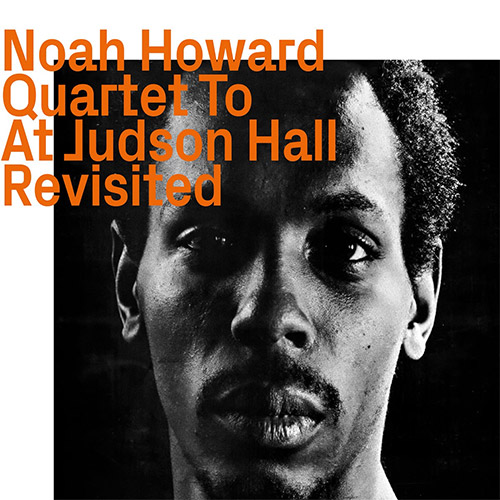

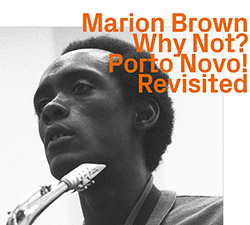



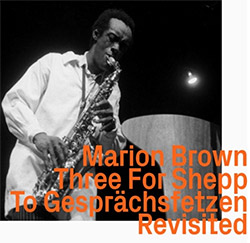


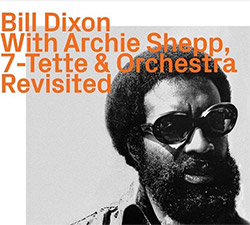


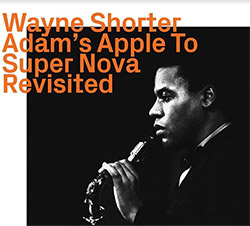
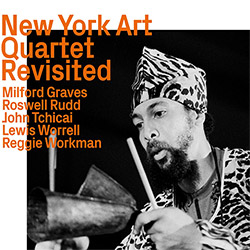


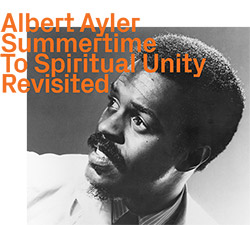
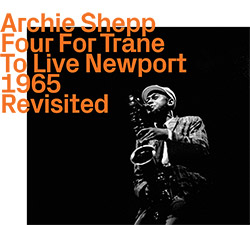
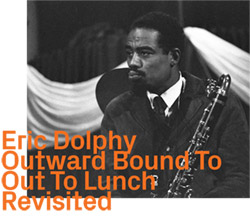
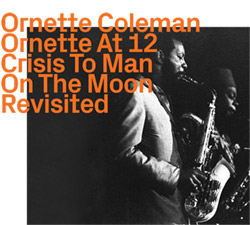

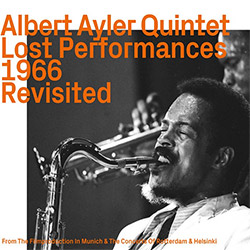

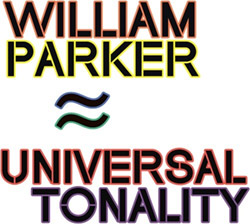
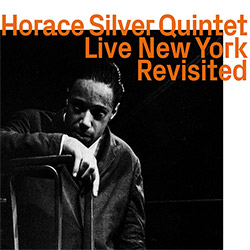



![Guy, Barry / Ken Vandermark: Occasional Poems [2 CDs]](https://www.teuthida.com/productImages/misc4/34849.jpg)
![Novoa / Carter / Mela Trio: Vol.1 [VINYL]](https://www.teuthida.com/productImages/misc4/35236.jpg)


![Elephant9 : Mythical River [VINYL]](https://www.teuthida.com/productImages/misc4/34624.jpg)
![Evans, Peter (Evans / Eldh / Black): Extra [VINYL]](https://www.teuthida.com/productImages/misc4/35279.jpg)

![McPhee, Joe: Straight Up, Without Wings [BOOK]](https://www.teuthida.com/productImages/misc4/35454.jpg)
![Jeck, Philip: rpm [2 CDs]](https://www.teuthida.com/productImages/misc4/35455.jpg)













![Barker / Parker / Irabagon: Bakunawa [VINYL]](https://www.teuthida.com/productImages/misc4/35533.jpg)
![Blaser, Samuel / Marc Ducret / Peter Bruun: Dark Was The Night, Cold Was The Ground [VINYL 10-inch]](https://www.teuthida.com/productImages/misc4/35492.jpg)








![Warren, Kenny (Warren / Hoffman / Ellman): Sweet World [VINYL]](https://www.teuthida.com/productImages/misc4/35451.jpg)




![Blake, Ran / Dave Knife Fabris: Live Amsterdam 2006, First Visit [CD + POSTCARDS]](https://www.teuthida.com/productImages/misc4/35275.jpg)













![DNS: Taking Big Bites Of The Khandas Three Cafes Deep [2 CDs]](https://www.teuthida.com/productImages/misc4/35334.jpg)




![Cleaver, Gerald: The Process [VINYL]](https://www.teuthida.com/productImages/misc4/34966.jpg)




![Alva Noto: HYbr:ID II [VINYL 2 LPs]](https://www.teuthida.com/productImages/misc4/35201.jpg)

![Baron, Derek / Luke Martin: Distinct and Concealed [CASSETTE + DOWNLOAD]](https://www.teuthida.com/productImages/misc4/35079.jpg)

![Lyle, Erica Dawn : Colonial Motels [CASSETTE + DOWNLOAD]](https://www.teuthida.com/productImages/misc4/35080.jpg)









![Sanna, Claudio: Compositori Sardi Contemporanei II [2 CDs]](https://www.teuthida.com/productImages/misc4/35317.jpg)







![Zurria, Manuel: Fame di Vento [3 CDs]](https://www.teuthida.com/productImages/misc4/35167.jpg)

![Granberg, Magnus / Nattens Inbrott / Skogen: Holde Traume, Kehret Wieder! [2 CDs]](https://www.teuthida.com/productImages/misc4/35038.jpg)
![Frey, Jurg: Outermost Melodie [2 CDs]](https://www.teuthida.com/productImages/misc4/35039.jpg)

![Pavone, Jessica: Reverse Bloom [VINYL]](https://www.teuthida.com/productImages/misc4/34895.jpg)




![Modney (Modney / Wooley / Gentile / Roberts / Pluta / Symthe / ...): Ascending Primes [2 CDs]](https://www.teuthida.com/productImages/misc4/34852.jpg)









![Elephant9 with Terje Rypdal: Catching Fire [VINYL 2 LPs]](https://www.teuthida.com/productImages/misc4/35355.jpg)
![Deerlady (Obomsawin, Mali / Magdalena Abrego): Greatest Hits [VINYL]](https://www.teuthida.com/productImages/misc4/34876.jpg)




![Haino, Keiji: Black Blues [2 CDs]](https://www.teuthida.com/productImages/misc4/35109.jpg)



![Surplus 1980: Illusion of Consistency [CD]](https://www.teuthida.com/productImages/misc4/35069.jpg)
![Staiano, Moe: Away Towards the Light [VINYL + DOWNLOAD]](https://www.teuthida.com/productImages/misc4/35037.jpg)



![Caveira (Gomes / Sousa / Abras / Ferrandini): Ficar Vivo [VINYL]](https://www.teuthida.com/productImages/misc4/34643.jpg)
![Gregg, J. J. / David Van Auken: Lunar Prairie [CD w/ DOWNLOAD]](https://www.teuthida.com/productImages/misc4/34611.jpg)

![Coultrain: Mundus [VINYL]](https://www.teuthida.com/productImages/misc4/32439.jpg)
![Mattin: Songbook #6 [VINYL]](https://www.teuthida.com/productImages/misc4/27317.jpg)
![Punkappella: Wake Up [7-inch VINYL]](https://www.teuthida.com/productImages/misc4/17519.jpg)
![Residents, The: WARNING: UNiNC.: Live And Experimental Recordings 1971-1972 [VINYL 2 LPs]](https://www.teuthida.com/productImages/misc4/31521.jpg)
![Coultrain: Phantasmagoria [VINYL]](https://www.teuthida.com/productImages/misc4/30142.jpg)
![Lennon, Sean Ono: Asterisms [VINYL]](https://www.teuthida.com/productImages/misc4/34517.jpg)

![Coley, Byron: Dating Tips for Touring Bands [VINYL]](https://www.teuthida.com/productImages/misc4/17906.jpg)

![Lost Kisses: My Life is Sad & Funny [DVD]](https://www.teuthida.com/productImages/misc4/lostKissesDVD.jpg)